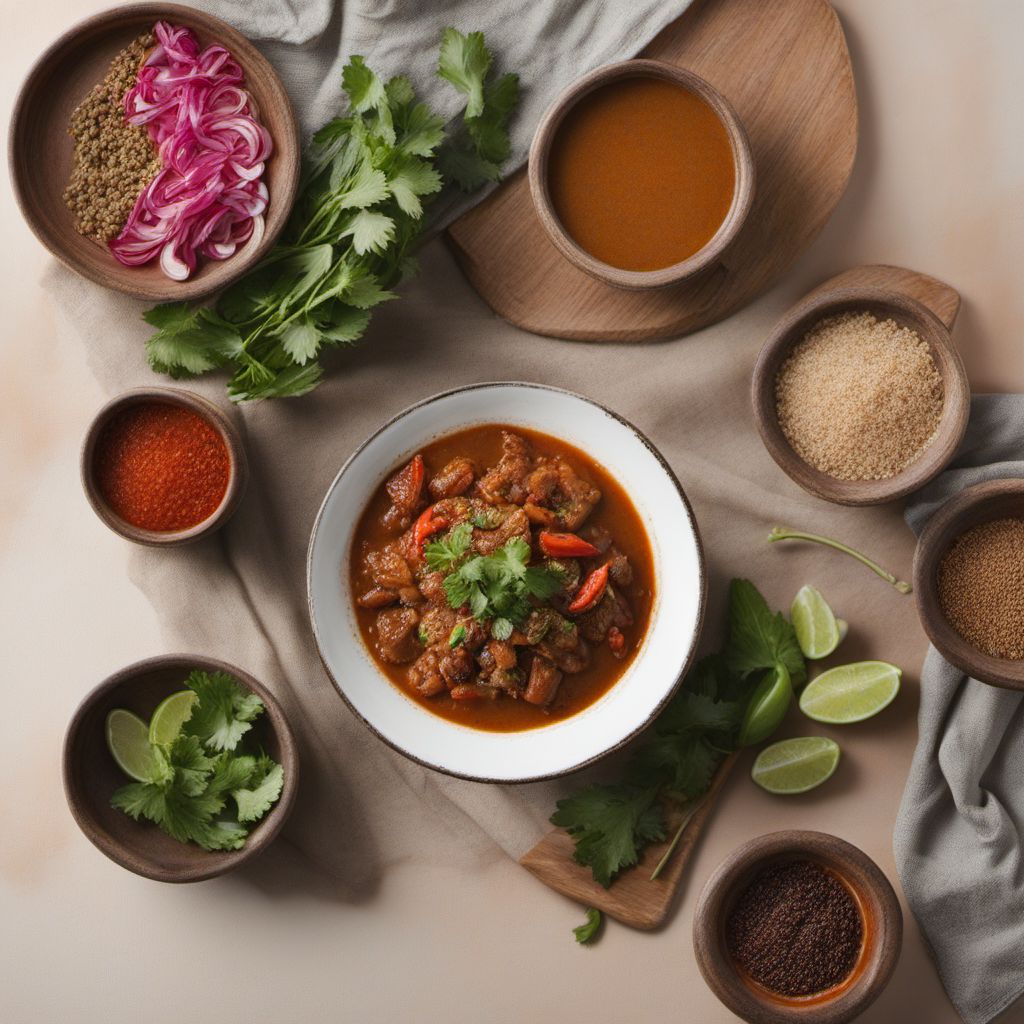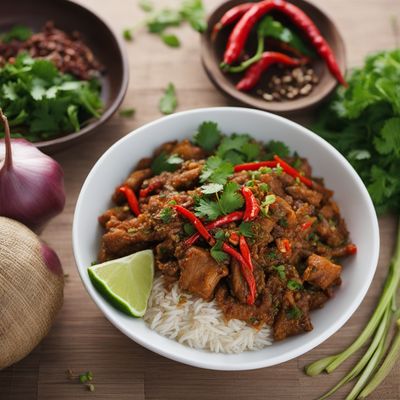
Recipe
Hmong-inspired Chilorio
Savory Hmong Pork Stew with a Mexican Twist
4.7 out of 5
This Hmong-inspired Chilorio recipe combines the rich flavors of Mexican cuisine with the traditional cooking techniques of Hmong cuisine. Tender pork is slow-cooked in a fragrant blend of spices, resulting in a hearty and flavorful stew that will transport you to the vibrant streets of Hmong communities.
Metadata
Preparation time
20 minutes
Cooking time
2 hours
Total time
2 hours and 20 minutes
Yields
4 servings
Preparation difficulty
Easy
Suitable for
Gluten-free, Dairy-free, Low-carb, High-protein, Paleo
Allergens
N/A
Not suitable for
Vegan, Vegetarian, Pescatarian, Kosher, Halal
Ingredients
In this Hmong-inspired version of Chilorio, we incorporate traditional Hmong spices and cooking techniques to create a unique fusion dish. While the original Mexican Chilorio uses pork marinated in a mixture of citrus juices, in this adaptation we infuse the pork with Hmong flavors by using a blend of cumin, garlic, and paprika. Additionally, we slow-cook the pork to achieve a tender texture, which is a common cooking method in Hmong cuisine. We alse have the original recipe for Chilorio, so you can check it out.
-
2 pounds (900g) pork shoulder, cut into chunks 2 pounds (900g) pork shoulder, cut into chunks
-
2 tablespoons vegetable oil 2 tablespoons vegetable oil
-
1 onion, finely chopped 1 onion, finely chopped
-
4 cloves garlic, minced 4 cloves garlic, minced
-
2 teaspoons ground cumin 2 teaspoons ground cumin
-
1 teaspoon paprika 1 teaspoon paprika
-
1 teaspoon dried oregano 1 teaspoon dried oregano
-
1 teaspoon salt 1 teaspoon salt
-
1/2 teaspoon black pepper 1/2 teaspoon black pepper
-
2 cups (470ml) chicken broth 2 cups (470ml) chicken broth
-
2 tablespoons white vinegar 2 tablespoons white vinegar
-
2 bay leaves 2 bay leaves
Nutrition
- Calories (kcal / KJ): 380 kcal / 1590 KJ
- Fat (total, saturated): 24g, 8g
- Carbohydrates (total, sugars): 2g, 1g
- Protein: 38g
- Fiber: 0g
- Salt: 1.5g
Preparation
-
1.Heat the vegetable oil in a large pot over medium heat. Add the chopped onion and minced garlic, and sauté until they become translucent.
-
2.Add the pork chunks to the pot and cook until browned on all sides.
-
3.In a small bowl, combine the ground cumin, paprika, dried oregano, salt, and black pepper. Sprinkle this spice mixture over the pork, stirring well to coat the meat evenly.
-
4.Pour in the chicken broth and white vinegar, and add the bay leaves. Stir to combine.
-
5.Reduce the heat to low, cover the pot, and simmer for about 2 hours, or until the pork is tender and easily shreds with a fork.
-
6.Once the pork is cooked, remove the bay leaves and use two forks to shred the meat into smaller pieces.
-
7.Serve the Hmong-inspired Chilorio over steamed rice or with warm tortillas.
Treat your ingredients with care...
- Pork shoulder — Choose a well-marbled cut of pork shoulder for the best flavor and tenderness. Trim off any excess fat before cooking.
- Ground cumin — Toasting the cumin seeds before grinding them will enhance their flavor. Simply heat a dry skillet over medium heat, add the cumin seeds, and toast for a few minutes until fragrant. Then grind them using a mortar and pestle or a spice grinder.
Tips & Tricks
- For a spicier version, add a diced jalapeno or serrano pepper to the pot along with the onions and garlic.
- If you prefer a thicker sauce, remove the lid during the last 30 minutes of cooking to allow the liquid to reduce.
- Leftovers can be stored in the refrigerator for up to 3 days and taste even better the next day as the flavors continue to develop.
Serving advice
Garnish the Hmong-inspired Chilorio with fresh cilantro leaves and serve it with a side of steamed rice or warm tortillas. This dish pairs well with a refreshing cucumber salad or pickled vegetables to balance the richness of the stew.
Presentation advice
Serve the Hmong-inspired Chilorio in a deep bowl, allowing the vibrant red color of the stew to stand out. Sprinkle some chopped fresh cilantro on top for a pop of green, and serve with a side of steamed rice or warm tortillas.
More recipes...
For Mexican cuisine » Browse all
More Mexican cuisine dishes » Browse all

Pan de camote
Pan de camote is a traditional Filipino bread made with sweet potato. It is a soft, slightly sweet bread that is perfect for breakfast or as a snack.

Garnacha
Garnacha is a popular Spanish dish that is loved for its bold and spicy flavors. It is a perfect meal for any time of the day.

Caldo de pollo ranchero
Ranch-style chicken soup
Caldo de pollo ranchero is a traditional Mexican soup that is made with chicken and a variety of vegetables and spices.








